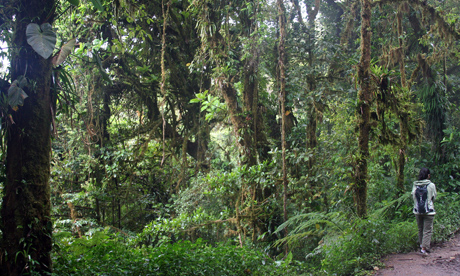
Costa Rica's thick, tropical cloud forests (like something straight from Jurassic Park) offer more than monkey sightings. Don't miss Rob Bailes' five favourite activities
Monteverde’s fame as a bird watcher's paradise is richly deserved. Boasting over 450 bird species – more than half of all species found in Costa Rica – Monteverde’s many accessible field stations and forest reserves offer something for everyone, whether you are a recreational bird-watcher or professional ornithologist. Resplendent quetzals, three-wattled bellbirds, flycatchers, parakeets, toucanets and tityras are just a few of the vivid bird species that saturate Monteverde’s local forests.
Choose your time carefully, however. More than 20% of birds found in Monteverde are long-distance migrants and can only be spotted at certain times of the year. To see the famous resplendent quetzal and three-wattled bellbird you will need to visit sometime between March and August, during the breeding season. Local tour guides can be arranged through the local reserve network comprising the Monteverde Cloud Forest Reserve, the Santa Elena Cloud Forest Reserve, the Children’s Eternal Rainforest and the San Luis Reserve. For an unparalleled off-the-beaten-track experience, enquire in advance about one of the several field stations owned and ran by the reserves. Bird and wildlife conservation is part and parcel of life in Monteverde.
Getting off-the-beaten-track in Monteverde is difficult if you don’t know your way around. There are few official public footpaths or publicly accessible trail networks outside of the principal reserves. Given much of the local economic revenue (much of which is invested back into local conservation) is generated by official guided tours and reserve entry fees, there has been little incentive or resource to develop a public trail network. Still, options do exist for the more adventurous traveller.
Try hiking from Monteverde down to the village of San Luis, by either the old road past the Colina Lodge. The trek's mid-way point offers a sensational panorama across the roof of the cloud forest and out to the Gulf of Nicoya. A local tilapia farm and restaurant, Rancho de Lelo – open Wednesday to Sunday – awaits the weary traveller at the bottom end of San Luis. Few tourists make it this far.
Alternatively try renting out, and then hiking to, rustic farm house and shelter Albergue Amapala, tucked high up on the San Luis mountain side. This is one of the first stop-off points of an ambitious new project to develop an open-source trail network extending from the Cloud Forest Reserve right down to the Gulf of Nicoya. Known locally as Sendero Pacífico (Pacific footpath), the trail network will be co-managed by regional organisations, with local communities developing and maintaining trail networks within their geographic area of interest.
For more information or to enquire about the shelter, contact: [email protected]
Monteverde offers much more than just wildlife. In recent years a number of local trail running events have sprung up taking advantage of Monteverde’s unique topography and breathtaking landscape. The routes traversed by these events offer travellers a unique opportunity to see parts of the local area they would not otherwise visit. There are few better ways to discover the ‘real’ Monteverde than by running through the cloud forest atop the continental divide.
For those travelling in December, look to one of the newest and most challenging of Monteverde’s trail running events: the MoonRun. Incorporating three different race distances – 15k, 25k, 65k – the run begins in the day and ends at night and has quickly become a firm fixture on the racing calendar for local, hardened trail runners. The event welcomes tourists and is organised by home-grown company Lead Adventure Media.
If you are visiting in June, look to the Monteverde Cloud Forest Run. Larger and more commercialised, the race covers 11.5k beginning and ending in Santa Elena town by way of the cloud forest reserve. The run is open to beginners, amateurs as well as professional racers who come from all over Costa Rica. The event is a much anticipated event in the local community calendar.
Combine Monteverde’s rich biodiversity with its high concentration of local biologists and ecologists and you get a heady mix ripe for educational tourism. Monteverde offers a wide variety of study abroad programmes which seek to connect student visitors with local environmental, social and economic challenges as well as the pioneering initiatives seeking to address them. One organisation, the Monteverde Institute, has been leading the way in cultural exchange and study abroad programmes in the area for nearly three decades. A non-profit organisation founded in 1986, the Institute sits in a 38-acre campus forming part of the famous Monteverde Cloud Forest Reserve Complex. It combines international study abroad, applied research and community engagement with a focus on sustainable development, Spanish language and culture, and conservation biology. Other educational institutions operating in Monteverde and the nearby village of San Luis include the international non-profit, CIEE, UGA Costa Rica and the private Spanish language immersion school, CPI. The former offers undergraduate tropical ecology and conservation courses from September to November each year.
Like many tourism destinations located in economically poor but biologically rich regions of the world, Monteverde faces a complex set of social, economic and environmental challenges. Tourism is good, but it must be managed responsibly and for the benefit of the local community and the environment. A number of local voluntourism opportunities exist in Monteverde which provide visitors the opportunity to take part in vital conservation initiatives.
One of these – Monteverde Travellers’ Philanthropy – is currently working with businesses, community-leaders and development institutions to create a community-managed fund designed to channel resources into locally-identified environmental conservation and sustainable development projects.
As of April this year, pre-arranged groups will be able to take part in this innovative programme by signing up to a not-for-profit educational tour facilitated by the Monteverde Community Fund. The “city tour” will combine interaction with local community groups and leading businesses with a walk and talk introduction to Monteverde’s environmental, cultural and development history.